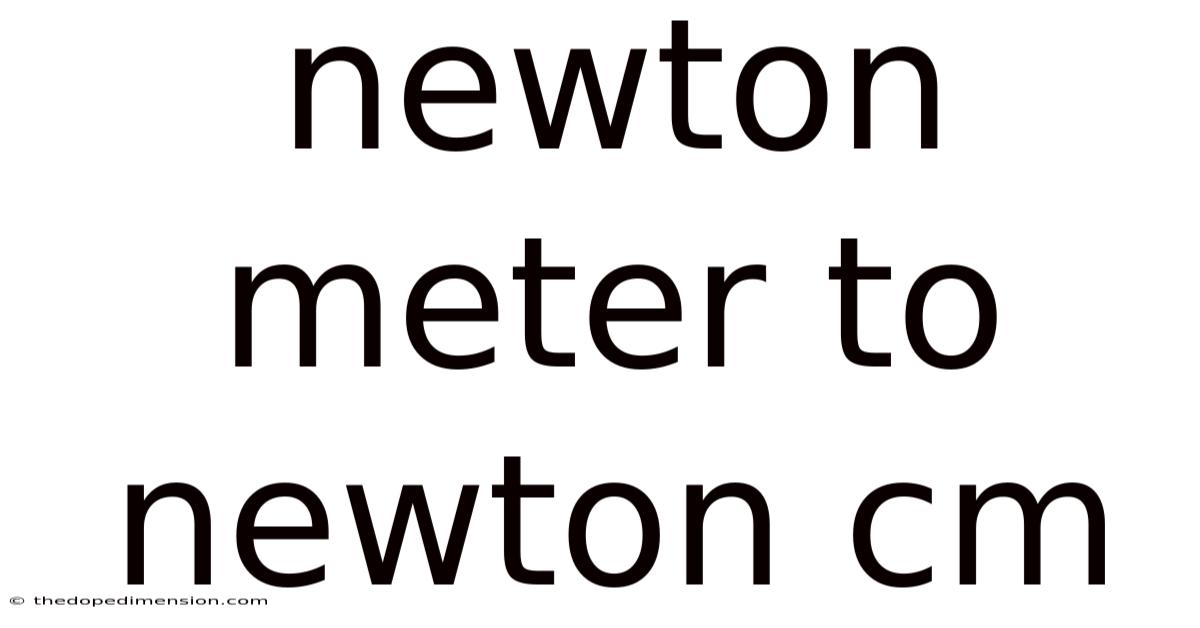Newton Meter To Newton Cm
thedopedimension
Aug 25, 2025 · 4 min read

Table of Contents
Unlocking the Conversion Mystery: Newton Meters to Newton Centimeters
Understanding units of measurement is fundamental in physics and engineering. Often, we encounter situations where we need to convert between different units to ensure consistency and accurate calculations. This article delves into the conversion process between Newton meters (Nm) and Newton centimeters (Ncm), two units representing torque or moment of force. We'll explore the underlying principles, provide a step-by-step guide to the conversion, offer practical examples, and address frequently asked questions to solidify your understanding. This comprehensive guide will equip you with the knowledge to confidently navigate these unit conversions in various applications.
Understanding Torque and its Units
Before diving into the conversion, let's briefly review the concept of torque. Torque, also known as the moment of a force, is a measure of how much a force acting on an object causes that object to rotate. It's calculated as the product of the force applied and the perpendicular distance from the point of application of the force to the axis of rotation.
The standard unit for torque in the International System of Units (SI) is the Newton meter (Nm). It represents the torque produced by a force of one Newton acting at a perpendicular distance of one meter from the axis of rotation. While less common in the SI system, the Newton centimeter (Ncm) represents the torque produced by a force of one Newton acting at a perpendicular distance of one centimeter from the axis of rotation.
The Conversion Process: Nm to Ncm
The conversion from Newton meters to Newton centimeters is a straightforward process based on the relationship between meters and centimeters. Since there are 100 centimeters in one meter, the conversion factor is simply 100.
To convert Newton meters (Nm) to Newton centimeters (Ncm), multiply the value in Nm by 100.
The formula can be expressed as:
Ncm = Nm * 100
Step-by-Step Conversion Guide
Let's illustrate the conversion process with a step-by-step example. Suppose we have a torque of 5 Nm and we want to convert it to Ncm.
Step 1: Identify the value in Nm.
In this case, the value is 5 Nm.
Step 2: Apply the conversion formula.
Ncm = Nm * 100
Ncm = 5 Nm * 100
Step 3: Perform the calculation.
Ncm = 500 Ncm
Therefore, a torque of 5 Nm is equivalent to 500 Ncm.
Practical Examples
Here are a few more examples to solidify your understanding:
-
Example 1: Convert 12 Nm to Ncm.
Ncm = 12 Nm * 100 = 1200 Ncm
-
Example 2: Convert 0.75 Nm to Ncm.
Ncm = 0.75 Nm * 100 = 75 Ncm
-
Example 3: Convert 2500 Ncm to Nm. (Note: This is the reverse conversion. Divide by 100).
Nm = 2500 Ncm / 100 = 25 Nm
The Importance of Unit Consistency
Maintaining unit consistency is crucial in any engineering or physics calculation. Using inconsistent units can lead to significant errors in your results. Always ensure that all your measurements are in the same system of units (SI, CGS, etc.) before performing any calculations. If necessary, convert all values to a common unit before proceeding.
Scientific Explanation and Dimensional Analysis
The conversion factor of 100 stems directly from the relationship between the meter and the centimeter in the metric system. The meter (m) is the base unit of length in the SI system, while the centimeter (cm) is a derived unit. One meter is equal to 100 centimeters (1 m = 100 cm).
From a dimensional analysis perspective, torque has dimensions of force times distance: [M L T⁻²] x [L] = [M L² T⁻²]. Both Nm and Ncm have the same dimensions, ensuring the conversion is valid. The only difference lies in the scale of the distance unit used.
Frequently Asked Questions (FAQs)
Q1: Can I use this conversion for all torque measurements?
A1: Yes, this conversion factor (multiplying by 100) applies universally to all torque measurements expressed in Nm and Ncm.
Q2: What if I have a torque value in another unit, such as pound-feet (lb-ft)?
A2: You would first need to convert the pound-feet to Newton meters using the appropriate conversion factors before applying the Nm to Ncm conversion.
Q3: Why is it important to use the correct units?
A3: Inaccurate units can lead to significant errors in calculations, potentially resulting in design flaws, safety hazards, or incorrect predictions. Consistent units are essential for accurate and reliable results.
Q4: Are there any other common units for torque?
A4: Yes, besides Nm and Ncm, other units include pound-feet (lb-ft), kilogram-meters (kg-m), and dyne-centimeters (dyn-cm).
Conclusion
Converting between Newton meters and Newton centimeters is a fundamental skill for anyone working with torque calculations. By understanding the underlying principles and applying the simple conversion factor of 100, you can easily switch between these units to ensure consistency and accuracy in your work. Remembering to maintain unit consistency throughout your calculations is paramount to avoiding errors and ensuring reliable results in any engineering or physics application. Always double-check your work and ensure that your chosen units align with the context of the problem. Mastering this conversion will significantly enhance your ability to work with torque effectively and confidently.
Latest Posts
Latest Posts
-
Convert 45 Cm To Inches
Aug 25, 2025
-
4 000 Seconds To Minutes
Aug 25, 2025
-
How Long Is 900 Seconds
Aug 25, 2025
-
Newton Metre To Kg Cm
Aug 25, 2025
-
How Many Inches Is 65mm
Aug 25, 2025
Related Post
Thank you for visiting our website which covers about Newton Meter To Newton Cm . We hope the information provided has been useful to you. Feel free to contact us if you have any questions or need further assistance. See you next time and don't miss to bookmark.